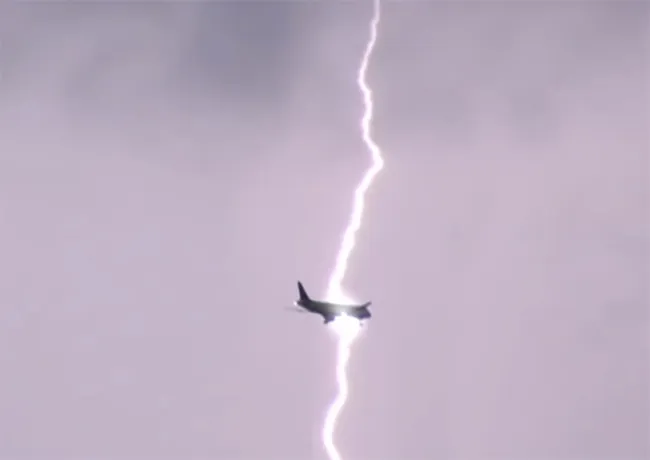
Lightning Strike
Oct 23, 2013

A lightning strike is a powerful natural phenomenon resulting from the discharge of electricity in the atmosphere, typically during thunderstorms. It occurs when the electrical charge in clouds builds up and seeks to equalize with the ground or another charged area. This sudden release of energy produces a bright flash of light and is accompanied by thunder, which is the sound of the rapid expansion of heated air. Lightning can reach temperatures of approximately 30,000 degrees Fahrenheit, making it hotter than the surface of the sun. It poses risks, including fires, injuries, and damage to structures, emphasizing the need for safety awareness during storms.
Lightning strikes are a fascinating and powerful natural phenomenon that can have devastating effects on both the environment and human life. Understanding the mechanics of lightning, its types, and safety measures can significantly reduce the risks associated with this incredible force of nature.
What is a Lightning Strike?
A lightning strike occurs when a discharge of electricity travels between the atmosphere and the ground. This phenomenon is typically associated with thunderstorms, where the electrical charges build up in clouds due to the movement of ice particles. When the electrical potential between these charges becomes too great, a lightning bolt is released, creating a bright flash and producing thunder.
Types of Lightning Strikes
There are several types of lightning strikes, each with distinct characteristics. Understanding these types can help in recognizing their potential dangers.
| Type of Lightning | Description |
|---|---|
| Cloud-to-Ground Lightning | The most common type, where a bolt travels from a cloud to the ground. |
| Intra-Cloud Lightning | Occurs within a single cloud, creating spectacular displays. |
| Ground-to-Cloud Lightning | A less common type where electricity travels from the ground up to the cloud. |
| Cloud-to-Cloud Lightning | Lightning that jumps between two clouds, often seen in distant thunderstorms. |
How Lightning Strikes Affect the Environment
Lightning strikes can have various impacts on the environment, from igniting wildfires to damaging ecosystems. The heat generated by a lightning strike can reach temperatures of approximately 30,000 degrees Fahrenheit, which is five times hotter than the surface of the sun. This intense heat can incinerate vegetation, leading to forest fires that can devastate large areas.
Lightning Safety Tips
When thunderstorms approach, it is crucial to take safety precautions. Here are some essential tips to stay safe during a lightning storm:
- Seek shelter indoors, away from windows and doors.
- Avoid using electrical appliances and devices.
- Stay away from tall objects, such as trees and poles.
- If outside, find a low-lying area and crouch down, minimizing your profile to the ground.
The Role of Technology in Lightning Detection
Advancements in technology have improved our ability to detect and predict lightning strikes. Meteorological organizations utilize radar and satellite data to monitor storm systems and provide timely warnings. This technology is crucial for minimizing risks, especially in areas prone to thunderstorms. Tools such as "lightning detection systems" can help track real-time lightning activity and alert individuals in danger.
Understanding the Science Behind Lightning
The science of lightning involves complex interactions between atmospheric conditions. "Thunderstorms" typically form when warm, moist air rises and cools, leading to condensation and cloud formation. This process generates electric charges through collisions between ice particles within the cloud. Once the charge differential becomes significant enough, a lightning strike occurs. Understanding this process is vital for developing effective "lightning safety protocols".
Impact of Lightning Strikes on Infrastructure
Lightning strikes can cause significant damage to buildings and infrastructure. The electrical surge can lead to fires, power outages, and equipment failures. Installing "lightning protection systems" can mitigate these risks, ensuring that structures are equipped to handle the impact of a lightning strike. These systems typically include lightning rods, grounding systems, and surge protectors.
Lightning Strike Statistics
Statistics reveal just how prevalent and dangerous lightning strikes can be. According to the National Oceanic and Atmospheric Administration (NOAA), approximately 25 million cloud-to-ground lightning strikes occur in the United States each year. On average, about 20 people are killed by lightning strikes annually in the U.S., emphasizing the importance of awareness and safety measures.
| Year | Lightning Strikes (millions) | Fatalities |
|---|---|---|
| 2018 | 20 | 20 |
| 2019 | 25 | 18 |
| 2020 | 30 | 23 |
| 2021 | 28 | 19 |
| 2022 | 22 | 21 |
Conclusion
Lightning strikes are awe-inspiring yet dangerous natural events. By understanding the mechanics of lightning, the types of strikes, and implementing safety measures, individuals can protect themselves and their property from the risks associated with this powerful force. As technology advances, our ability to predict and monitor lightning activity continues to improve, offering hope for reduced lightning-related incidents in the future.
Related Articles

Explore Thailand: The Best Islands to Visit for Paradise, Adventure, and Relaxation

The Ultimate Guide to the Best Islands in Thailand for Your Next Getaway

Do babies need passports? How to get a passport for a newborn

How to get a U.S. passport fast: here’s how to expedite the process

What is Mobile Passport Control: 5 reasons why you should use it

SENTRI vs. Global Entry: A detailed guide

Do you need a passport to go to the Bahamas? Let’s find out

Do you need a passport to go to Mexico? A detailed guide

Do you need a passport to go to Canada? We got the answer

Do You Need a Passport for a Cruise: An Essential Travel Guide

Booster Seat Requirements: All the Rules to Follow in Your Rental Car

What Are the World’s Most Powerful Passports, and How Does Yours Rank?

How to Take a Passport Photo at Home: A Helpful Guide

You've got to have heart! Southwest's new livery

Your opinion: Should water be free on low cost carriers?

Young women bolder than guys as solo travellers
